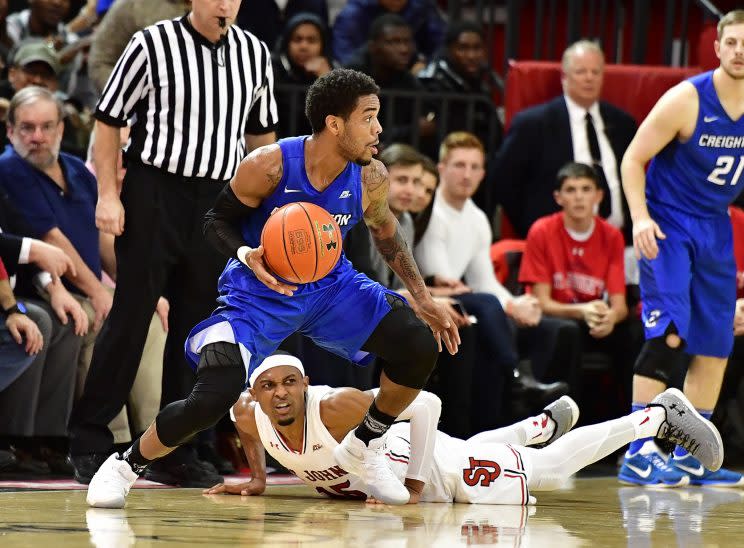Maurice Watson's injury is even more damaging to Creighton than you might think

First came the collision. Then the second fall. And the agony. Then came the hope. And the MRI. And, finally, the devastation.
Creighton’s worst fears were realized Tuesday when senior point guard Maurice Watson received the results of an MRI that confirmed he had torn the ACL in his left knee Monday against Xavier. Watson is out for the season. His college career is over in heartbreaking fashion.
And Creighton, which is 18-1 and ranked seventh in the nation, suddenly is in trouble.
Tuesday’s MRI results didn’t just confirm the ACL tear. They didn’t just rudely and devastatingly interrupt Creighton’s best season ever. They sent the Bluejays’ burgeoning Final Four candidacy skidding into reverse.
Creighton’s season isn’t over. Even without Watson for the majority of Monday’s game, the Bluejays held off a ranked Xavier team. But their grandest postseason aspirations, ones that were becoming increasingly realistic before Watson crumpled to the Cintas Center floor, crumpled along with their star.
Maurice Watson wasn’t the best player in college basketball. Nobody will argue that. Maurice Watson was, however, one of the most valuable, if not the most valuable player in college basketball. Given all of Watson’s attributes, his role, his experience, and Creighton’s lack of point guard depth, the list of players in college basketball whose values above replacement are greater than Watson’s is very short. Lonzo Ball is probably on it. Maybe Joel Berry or De’Aaron Fox. Not many others.
Watson was everything for a Creighton team that ranks 7th nationally in adjusted offensive efficiency. He was neither pass-first point guard nor score-first; he was both. The ball was in his hands so much, and he so often did wonderful things with it. He expertly navigated pick-and-rolls and pick-and-pops with Justin Patton and Toby Hegner. He would probe the lane, keep his dribble alive, and pick a pinpoint pass. He assisted on 44 percent of the team’s field goals when he was on the court, the fifth-highest such rate in the country. He shot 48.4 percent from three, and averaged 1.5 steals per game.
He was also a senior, a point guard, a great personality, a leader, and a floor general with a commanding presence despite his diminutive stature. He initiated Creighton’s transition offense expertly by pushing the ball himself and putting it ahead to teammates. The Bluejays’ average possession length is the ninth-shortest in the country. That’s in large part due to their point guard.
Watson’s creative qualities will be most sorely missed. In his absence, Creighton must compile a plan for replacing him from a rotation of guards that are — or at least have been — primarily comfortable off the ball. The three seeing significant minutes alongside Watson were Marcus Foster, Khyri Thomas and Isaiah Zierden. None of those three has an assist rate even one-third as high as Watson’s.

That doesn’t definitively say that none of the three can replicate Watson’s passing abilities. Watson’s assist numbers were so high in part because he had the ball so much. But, by the same token, he had the ball so much for a reason, namely because he was much more resourceful with it than the other three, and more resourceful with it than almost all college point guards. Watson had played 87.5 percent of available minutes in five Big East games pre-injury. No other option — not Khyri Thomas, a natural shooting guard; nor little-used freshman Davion Mintz; nor little-used junior Tyler Clement — was viable.
Now Creighton coach Greg McDermott must make one of them, or something else, viable. Or he must fundamentally alter his offense. He might have to do both.
“There’s going to be some experimentation in practice,” McDermott said at a press conference Wednesday. “We haven’t played much without Maurice, in games or in practice. So we have to tinker with some things and see what may work the best. … Obviously there’ll be some changes in what we do offensively, because a lot of what we did was built around his skillset.”
Personnel-wise, McDermott must take a player who was regularly on the end of Watson assists and put him on the ball, consistently run ball screens for him, and give him distributive responsibilities. The numbers, available on hoop-math.com, give a sliver of insight into just how different Watson’s role was than those of others:

The only player with a history of more on-ball responsibility is Foster. During his freshman and sophomore years at Kansas State, he played the majority of his minutes at the two, but spent some time as the lead guard. In 2013/14, his assist rate was 20.9. Both years, it was more than double what it has been so far in 2016/17.
Unless McDermott feels comfortable expanding the role of Mintz or Clement, or if he’s adamant about keeping Foster at shooting guard, expect the junior to take on the majority of the load left behind by Watson. Foster isn’t capable of doing exactly what Watson did, but he can be more than serviceable.
Foster, though, was having the best and most efficient offensive year of his career. A somewhat drastic role change will hurt his efficiency and that of Creighton’s offense.
There’s also the matter of the offense’s tempo. “Our program is about pace,” McDermott said Wednesday. “That’s the way our guys want to play, and we’ll continue to push forward with that same tempo.” But it won’t be easy, nor will it be the same.
The Bluejays still have a lot going for them. Patton is getting better by the week. Foster is a very good Big east player. Cole Huff is an underrated weapon. McDermott is a great offensive coach.
But none of those positives make Watson’s injury any less devastating, and all of them combined won’t be enough to make Creighton a legitimate threat in March.

 Yahoo Sports
Yahoo Sports 

